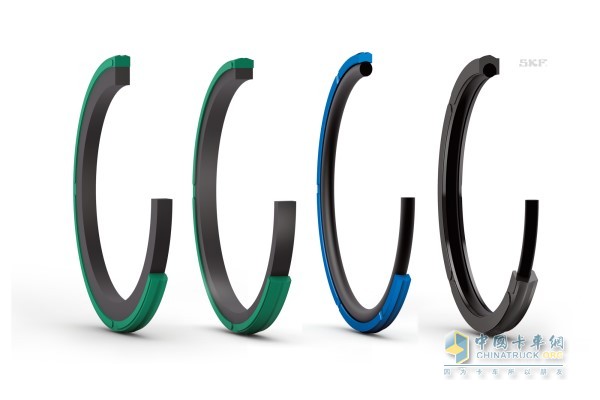 SKF piston seals for a wide range of hydraulic applications
SKF piston seals for a wide range of hydraulic applications If the basic parameters of the cylinder are not strict enough, the piston seal will also face enormous material engineering challenges. At high temperatures and pressures, hydraulic fluids are critical to the sealing material and may cause other components of the cylinder to expand and contract during operation.
PTFE materials meet these requirements. It has many features that are suitable for this function, including excellent low dynamics, static friction characteristics and good chemical resistance. However, PTFE seals also have their limitations. In particular, the limited flexibility of PTFE seals makes it difficult to achieve non-destructive installation. The PTFE seal needs to be stretched with a special expansion sleeve before installation and must be calibrated back to the correct diameter. For equipment manufacturers and maintenance teams, this process takes longer and more cost. In addition, the plasticity of PTFE means that it is difficult to restore its original shape under continuous torsional loading, limiting its sealing properties.
To overcome the shortcomings of PTFE seals, SKF's team of engineers tried to develop a sealing technology that could replace it based on the company's proven ECOPUR polyurethane material.
Manufacturing polyurethane seals that match the good performance of PTFE seals is far from paper. Wolfgang Swete, director of strategic product line development for SKF Fluid Seals, explains, “The gap between the piston and the barrel means you need an anti-extrusion A material with good enough performance to maintain its shape under all operating conditions."
SKF tested prototype seals made from its hardest Ecopur polyurethane and found that it could not achieve its goals. However, SKF has made a special grade of Ecopur material with its own advantages in material development and manufacturing capabilities, specifically for piston seals. This new material - X-Ecopur PS - is currently the hardest polyurethane produced by SKF.
To test the durability of the new material, SKF conducted a series of static anti-extrusion tests, which were mounted in a fixture at a pressure of 500 bar and the extrusion gap was adjusted to 0.15 mm to 0.7 mm depending on the seal size. The sample is then held in the fixture for two weeks at a temperature between 60oC and 100oC, and the permanent deformation of the sample is measured at the end of the test. “The X-Ecopur PS outperformed other commercial materials throughout the testing process,†says Swete.
With the right materials, the SKF team began to design a reasonable sealing section. This is a familiar area for SKF engineers. They use a fairly mature product development process, combined with a large number of computer simulations using finite element techniques, using CNC equipment to quickly develop prototypes and then customizing static and dynamic test equipment. Perform physical tests on it.
Through repeated research and development and testing processes, the company achieved the final result. The outer surface of the polyurethane slip ring has a shallow "M" shaped two optimized sealing lips. “Compared to flat seals, seals with a distinct seal point provide a more effective seal that improves seal performance while reducing the frictional resistance created by the seal,†says Swete. “Concentrating stress on two sealing faces instead of one side means that the seals will not tilt during use, and tilting will cause premature failure.â€
Further fine-tuning of the new generation of seal designs is related to the elastomer of the seal. It is a softer rubber component located below the polyurethane slip ring in the groove, pushing the slip ring toward the inner wall of the hydraulic cylinder. On light-loaded seals, the elastomer is a simple O-ring, while the medium to heavy-duty design uses a specially shaped nitrile rubber elastomer.
In SKF's new design, an oil groove is added to the side of the slip ring to ensure that pressure is quickly applied to the elastomer. This design allows the seal to switch position based on rapid changes in pressure direction, reducing the possibility of internal leakage and loss of hydraulic cylinder function. The side oil grooves also reduce the pressure between the slip ring and the elastomer, which can also result in loss of hydraulic cylinder function.
To validate the design, the prototype seals undergo further rigorous testing, including a 400mm stroke test cylinder operating at temperatures up to 250 bar and 80 °C for over 200 km. Friction and leakage are measured during the test and the seal is measured and inspected after the test is completed to see the extrusion and surface wear. “Our tests show that the new generation of seals has better performance than other commercial seals,†says Swete. “In fact, some of the standard seals we used for comparison failed before the end of the test.â€
SKF has now developed a full range of innovative piston seals for a wide range of hydraulic applications. The light-duty LPV series with O-ring elastomers is suitable for manufacturing machines for indoor and stationary applications. This series of seals is suitable for pressures up to 250 bar, speeds up to 0.5 m/s and temperatures ranging from -20 to 100 °C. The medium to heavy duty MPV series is suitable for demanding applications such as mobile equipment such as agricultural and construction machinery. MPV seals are suitable for metric grooves for pressures up to 400 bar, speeds up to 1 m/s and temperatures ranging from -20 to 110 °C. The third seal series is modeled as DPV and offers the same operating parameters as the MPV series for inch grooves.
“What makes me happy is not only the ability to create piston seals that stand out from any other polyurethane product,†concludes Swete. “And its performance is at least comparable to that of an excellent PTFE seal, with the added benefit of quick and easy installation, which benefits OEMs and maintenance personnel.â€
Reading volume: Source: SKF China Author: ZebianJiu Jitsu Mats,Judo Mats,Martial Arts Mats,High Jump Mat
Shenzhen Molding & Forming Industries Co.,ltd , https://www.mfi-cn.com